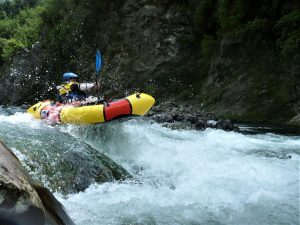A few words from a kayaker-come-packrafter
If you hadn’t noticed, packrafting is growing at a great pace, attracting trampers and adventure racers, and quite a few kayakers. One of packrafting’s principal attractions is the extremely short learning curve compared to whitewater kayaking. This exposes novice paddlers to moving water hazards from the first few minutes of taking it up, and more or less anyone can bomb down Grade 2 whitewater on their first day. This is a major challenge for Packrafting Association of New Zealand (PRANZ).
Our aim with PRANZ is to foster the safe enjoyment of packrafting. This means initially to set the benchmark for paddling safely and then to spread that culture of safety far and wide through the local paddling communities. Packrafters, like most kayakers, typically don’t form or join clubs. PRANZ has been running national and regional Meets and this has been a good social foundation.

PRANZ does not want to become a quasi-commercial instruction provider, so the focus is on turning individuals into paddlers who are aware of their place in a group. We have called this our Kaiārahi programme.
The Kaiārahi roles are:
- Facilitate safety brief and gear check
- Demonstrate and encourage good group teamwork
- Display good paddling form or simply point to other better paddlers
- Demonstrate, facilitate and encourage good scouting behaviour and safety
If this sounds like a kayak club trip leader’s role, that’s no coincidence. PRANZ leaves instruction (personal skills) to commercial entities and focuses on the social aspects of risk management. Rescue skills, specifically technical skills like people and gear recovery in whitewater, are mostly taught by professional instructors. A lot of this will be familiar to kayakers and rafters, but there are some specific differences due to two factors;
- Packrafts are extremely difficult to roll, so a capsize means a swim. Packraft instruction is heavy on active WW swimming and rapid re-entry. Rolling isn’t taught.
- Packrafts after a capsize are light and buoyant, unlike kayaks. This can reset priorities in a garage sale event.
Similar? Packrafters too, love rivers and whitewater – difficulty according to taste.
Different? Most packrafters actively enjoy a 4-5 hour hike into a Grade 2 run.
See you on the river,
Hugh Canard
